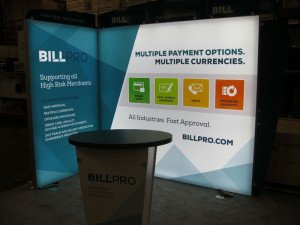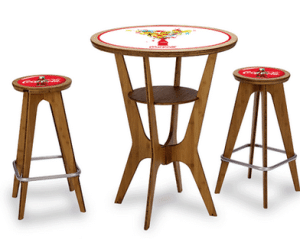Ceir Statistics: Effective Promotion for Your Trade Show Displays
CEIR, the Center for Exhibition Industry Research, regularly publishes some of the most complete and thorough statistics for the trade show industry, and virtually all their new publications hold valuable insights. Their latest publication, Cost To Attract Attendees, addresses one of the central issues of trade show display booth exhibiting: The rather high costs of generating leads.
It’s well-known that marketing with trade show displays is among the most expensive per-lead marketing methods, and CEIR’s data certainly supports that. However it mostly makes me wonder if it needs to be so expensive, in most cases. But, let’s start with what CEIR had to say.
CEIR And 2014 Exposition Marketing Budgets
Ultimately, CEIR found that the average cost of trade show marketing was upwards of $75,000 for a given exhibition, coming out with an median cost of about $20 per verified attendee, not per lead.
Now, it’s important to note that CEIR was surveying a wide range of trade shows, but tilted towards the upper end. So, those seven-figure megabooths that large companies put up in shows like E3 can quickly drag the averages upward.
That said, another recent article about trade show costs at the lower end wasn’t much more encouraging, coming up with an average of $12K and more than $200 per lead.
First and foremost, there are plenty of ways to reduce the costs of a trade show, with some creativity. But it still leaves the question of those huge marketing costs. Where it starts getting interesting is where the marketing focus lies.
Preferred Marketing Methods Among Current Trade Show Exhibitors
The real question is, where is that money going? According to virtually all respondents, mail was the most popular option. Direct email and direct physical mail were used by 90% of companies, and also cited as the most effective methods.
Overall, email was found to take up about 25% of marketing budgets, and another 30% went into direct physical mail.
The other interesting thing to note here is that, on average, no other tactic received more than 10% of the marketing budget. So, it would appear that most companies are largely relying on direct-mail methods, while deploying a smattering of other techniques as budget allows.
The other most popular options were:
- Print ads (79%)
- Social media (68%)
- Online advertisements like PPC (64%)
- Complementary tickets (48%) and
- Telemarketing (42%)
And then other options like radio or TV ads generally had less than 1/3 adoption, much less positive response rates.
Size Does Matter: Attendance And Spending
Another key finding in this study – one we haven’t seen discussed too often – is the relationship between the size/popularity of the trade show, and the spending associated. Here are a few key points they uncover:
- Small shows rely most heavily on electronic methods of contact, with “real world” spending scaling upwards alongside trade show attendance.
- Events with 4,500 to 10,000 guests seem to especially benefit from “social” outreach methods, such as social media or mobile messaging.
- While costs-per-lead tend to lower as the show size increases, this reverses for shows with more than 10,000 attendees. At that point, booth costs spike and keep spiking.
- Unsurprisingly, exhibitions expecting a large number of international visitors are the most expensive to promote, involving plenty of physical products and gifts.
So, no huge surprises here. This mostly confirms “common sense”wisdom on trade show visitation, but it’s good to see them put some hard numbers into the mix.
One point this study emphasizes is the need to strategically pick your trade shows. The size of the show has a distinct influence on the audience, and the best methods to reach them. Therefore, picking trade shows based on their size and also their focus – regional, national, international – is a valid tactic that will help you reduce your marketing spend.
And that’s what this all boils down to: Do exhibitors really NEED to be spending so much marketing trade show appearances?
Lowering The Costs Of Your Exposition Marketing
One issue with an overview survey like this is that it doesn’t go into too much detail on how all that money is actually being spent.
For example, if someone is spending 1/4 of their marketing budget onemail, I have to wonder what their workflow looks like and why emails cost that much. Email is free and ubiquitous – it feels like bureaucratic bloat must be at work here – perhaps they’re subcontracting the email marketing to expensive outside agencies?
The direct mail angle is also worth considering. Contrary to popular belief, direct mail is still a viable and relatively high-response method of outreach, even among younger buyers. (And keep in mind, more and more Gen Ys and Millennials will be given corporate purchasing power in years to come.)
So in this case, it makes sense there would be a higher spend there, especially since effective direct-mail items usually have to include “gimmicks” of some sort to inspire interaction. At the least, more costly printing techniques like foil inlay are needed to make them stand out among junk mail.
The issue is targeting, and making good mailers. We suggest:
- ALWAYS including a digital form of interaction, such as a scannable QR code, since that will give you the most precise numbers on effectiveness. Every scan tells you when the mailer was a success.
- Tracking response rates as you would your digital marketing. The pace is slower, but you can still focus on improving response through data-based feedback.
- Studying print ads of the 60s and 70s. Their methods of audience engagement are time-tested and can be updated to modern sensibilities without much trouble. (Less sexism, barcodes rather than coupons, etc.)
- Customizing the offers, but remember most people can still spot a form letter. Tripling your print costs just to include fill-in “lead’s name here” blanks is probably not worth the money unless the offer itself is similarly customized.
Emails and direct mails can cost as much as you want to spend, however, smart optimization of your content creation and targeting will drastically reduce booth marketing expenditures.
Optimizing Other Trade Show Marketing Spends
This leaves the less-commonly used marketing methods. Just as a few thoughts:
- Social and Pay-per-click marketing can be extremely cost-effective. Do your research, and target only the groups and websites MOST likely to contain interested visitors. Most companies who overspend on social and PPC are using unfocused “shotgun” strategies that increase the spend with minimal results.

- Radio advertising is, in our view, underrated. You can often negotiate good rates with local stations, and they’ll often be interested in cross-promotions at the event that can bring a lot of attention.
- Free tickets are fine, but be discriminating. In fact, consider giving them out to bloggers and other journalists, rather than your own leads.
- This might be controversial, but: stop telemarketing. The returns are quickly diminishing, and as a marketing form, it provides few -if any- advantages over other mediums. People don’t like being disturbed, and they don’t trust salesmen unless there’s a well-established relationship. Since trade shows are largely about outreach, that makes telemarketing a questionable and expensive tactic at best.
All in all, there’s no question that trade show attendance is expensive, but it is also proven to be very effective. Be smart with the marketing dollars – promoting a show appearance doesn’t need to break your budget. Smart targeting and selection of your marketing strategies can vastly increase your returns without boosting the costs.
